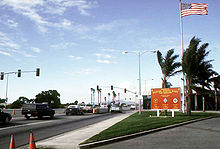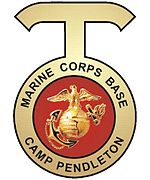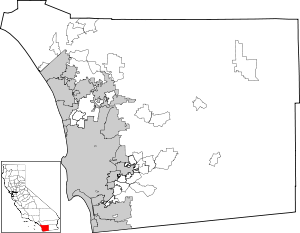- Marine Corps Base Camp Pendleton
-
Marine Corps Base Camp Pendleton San Diego County, California
MCB Camp Pendleton InsigniaType Military base Coordinates 33°20′N 117°25′W / 33.333°N 117.417°WCoordinates: 33°20′N 117°25′W / 33.333°N 117.417°W Built March 1942 In use September 25, 1942—present Controlled by United States Marine Corps Garrison I Marine Expeditionary Force Current
commanderColonel Nicholas F. Marano[1]
Shown within San Diego County, CaliforniaMarine Corps Base Camp Pendleton is the major West Coast base of the United States Marine Corps and serves as its prime amphibious training base.[2] It is located on the Southern California coast, in San Diego County, and bordered by Oceanside to the south, San Clemente, Cleveland National Forest, Orange and Riverside counties to the north, and Fallbrook to the east.
The base was established in 1942 to train U.S. Marines for service in World War II. By October 1944, Camp Pendleton was declared a "permanent installation" and by 1946, it became the home of the 1st Marine Division. It was named after Marine General Joseph Henry Pendleton (1860–1942), who had long advocated in setting up a training base for the Marine Corps on the west coast. Today it is the home to myriad Operating Force units including the I Marine Expeditionary Force and various training commands.
Contents
History
Prior to World War II
In 1769, a Spaniard by the name of Capt. Gaspar de Portola led an expeditionary force northward from lower California, seeking to establish Franciscan missions throughout California. On July 20 of that same year, the expedition arrived at the location now known as Camp Pendleton, and as it was the holy day St. Margaret, they baptized the land in the name of Santa Margarita.
During the next 30 years, 21 missions were established, the most productive one being Mission San Luis Rey, just south of the present-day Camp Pendleton.[3] At that time, San Luis Rey Mission had control over the Santa Margarita area.
In 1821, following Mexico’s independence from Spain, Californios became the new ruling class of California, and many were the first generation descendants of the Portola expedition. The Mexican governor awarded land grants and ranchos to prominent businessmen, officials and military leaders. In 1841, two brothers, Pio Pico and Andres Pico, became the first private owners of Rancho Santa Margarita. More land was later added to the grant, giving it the name of Rancho Santa Margarita y Las Flores, which stayed with the ranch until the Marine Corps acquired it in 1942. The design of the ranch's cattle brand is seen in the base's logo today.[4]
In 1863, an Englishman named John (Don Juan) Forster (Pio Pico’s brother-in-law) paid off Pico’s gambling debts in return for the deed to the ranch. During his tenure as owner of the ranch, he expanded the ranch house, which was first built in 1827, and developed the rancho into a thriving cattle industry.
Forster’s heirs, however, were forced to sell the ranch in 1882 because of a string of bad luck, which included a series of droughts and a fence law that forced Forster to construct fencing around the extensive rancho lands. It was purchased by wealthy cattleman James Flood and managed by Irishman Richard O’Neill who was eventually rewarded for his faithful service with half ownership. Under the guidance of O’Neill’s son, Jerome, the ranch began to net a profit of nearly half a million dollars annually, and the house was modernized and furnished to its present form.
World War II
 The main gate of Camp Pendleton; this is the main road for traffic into the base. This gate has been open and manned by Marines 24 hours a day since 1942.[citation needed] 33°12′53″N 117°23′15″W / 33.2147°N 117.3875°W
The main gate of Camp Pendleton; this is the main road for traffic into the base. This gate has been open and manned by Marines 24 hours a day since 1942.[citation needed] 33°12′53″N 117°23′15″W / 33.2147°N 117.3875°W
In the early 1940s, both the Army and the Marine Corps were looking for land for a large training base. The Army lost interest in the project, but in February 1942 it was announced that the 122,798 acres (497 km2) of Rancho Santa Margarita y Los Flores was about to be transformed into the largest Marine Corps base in the country.[5] It was named for Major General Joseph Henry Pendleton who had long advocated the establishment of a West Coast training base. Construction began in April but the base was considered a temporary facility so it was built to minimum standards of wood frame construction.[5] After five months of furious building activity, the 9th Marine Regiment, under then Colonel Lemuel C. Shepherd, Jr., marched from Camp Elliott in San Diego to Camp Pendleton to be the first troops to occupy the new base. On September 25, 1942, President Franklin D. Roosevelt officially dedicated the base.[2]
Korean War through the 1990s
During the Korean War, $20 million helped expand and upgrade existing facilities, including the construction of Camp Horno. When Camp Pendleton trained the country's fighting force for the Korean and Vietnam Wars, approximately 200,000 Marines passed through the base on their way to the Far East.
In 1975 Camp Pendleton was the first military base in the U.S. to provide accommodations for Vietnamese evacuees in Operation New Arrivals; over 50,000 refugees came to the base in the largest humanitarian airlift in history.[6][7]
Camp Pendleton has continued to grow through renovations, replacing its original tent camps with more than 2,600 buildings and 500 miles of roads.
Efforts today continue to preserve the heritage of Camp Pendleton's founders and the Marine Corps' history. The original ranch house has been declared a National Historic Site.
Present
 An M1 Abrams breaches the obstacle belt during an amphibious exercise in 1997.
An M1 Abrams breaches the obstacle belt during an amphibious exercise in 1997.
The base's diverse geography, spanning over 125,000 acres (506 km2), plays host to year-round training for Marines in addition to all other branches of the U.S. military. Amphibious and sea-to-shore training takes place at several key points along the base's 17 miles (27 km) of coastline. The main base is in the Mainside Complex, at the southeastern end of the base, and the remote northern interior is an impact area. Daytime population is around 100,000. Recruits from nearby Marine Corps Recruit Depot, San Diego spend a month on Pendleton's Edson Range receiving field training, and after graduating from boot camp return to the base's School of Infantry for further training. Camp Pendleton remains the last major undeveloped portion of the Southern California coastline, save for a few small state parks. In this way, it acts as a kind of buffer between Orange County and San Diego County.
Beginning in 1954, Camp Pendleton has hosted a variation of Basic Training familiarization for teenagers age 14 to 17. This training, called "Devil Pups", promotes physical fitness, instills discipline and promotes love of country and the Marine Corps.[8]
Since August 2004, Camp Pendleton has been one of five locations in the Department of Defense to operate the Standard Terminal Automation Replacement System (STARS) air radar. The STARS radar allows the facility to simulate air traffic for training purposes.[citation needed]
On Tuesday, September 20th, 2011, a AH-1W Super Cobra military helicopter crashed during a training exercise, killing two Marines.[9][10]
Unit locations (by area)
- 11 Area — 1st Marine Division headquarters
- 13 Area (Mainside) — Headquarters Area - 1st Marine Logistics Group; 9th Communications Battalion; 1st Radio Battalion; 1st Intelligence Battalion; 1st Dental Battalion; Marine Corps Installations West Headquarters
- 14 Area — Combat Logistics Regiment 1; Combat Logistics Regiment 17; 7th Engineer Support Battalion; Combat Logistics Battalion 1
- 15 Area — Security Battalion
- 21 Area (Camp Del Mar) — I Marine Expeditionary Force Headquarters; 3rd Assault Amphibian Battalion; Combat Logistics Battalion 5; Field Medical Training Battalion.
- 22 Area (Camp Chappo) — 1st Medical Battalion
- 23 Area (MCAS Camp Pendleton) — Marine Aircraft Group 39
- 24 Area (Camp Vado Del Rio) — MAG-39 Barracks; Base Brig
- 25 Area (Vado Del Rio) Marine Wing Support Squadron 372
- 31 Area (Edson Range) — Weapons & Field Training Battalion
- 32 Area — MASS-3, 3d LAAD Bn, MACS-1 Det A
- 33 Area (Camp Margarita) — 1st Reconnaissance Battalion
- 41 Area (Camp Las Flores) — 1st Light Armored Reconnaissance Battalion; 4th Light Armored Reconnaissance Battalion, 1st Air Naval Gunfire Liaison Company
- 43 Area (Camp Las Pulgas) — 11th Marine Regiment; 1st Maintenance Battalion
- 52 Area (Camp San Onofre) — United States Marine Corps School of Infantry
- 53 Area (Camp Horno) — 1st Marine Regiment; 1st battalion, 4th Marine Regiment
- 62 Area (Camp San Mateo) — 5th Marine Regiment; 1st Combat Engineer Battalion
- 63 Area (Camp Talega) — Reserve Support Unit (West)
Ecology
Camp Pendleton was built on a wide swath of coastal land that once supported an estuary at the mouth of the Santa Margarita River and extensive salt marsh habitat.[11] Outlying land within the base is made up of floodplain, oak woodlands, coastal dunes and bluffs, coastal sage scrub, chaparral, and several types of wetlands, including ephemeral wetlands such as vernal pools.[12] Wildfire is not uncommon.[12] Research in ecology takes place in undeveloped areas of base, which contain examples of rare and endangered California habitat types. The Department of Defense has issued management plans for various ecosystems on this territory.[12]
Land within the base still includes breeding habitat for birds such as the Western Snowy Plover[11] and California Gnatcatcher.[13] The coastal bluffs have many of the few existing specimens of the Pendleton button-celery, which was named for the base.[14] Rare mammals on the base include the Pacific pocket mouse and Stephens' kangaroo rat.[12]
See also
- List of United States Marine Corps bases
- Marine Corps Air Station Camp Pendleton
- WWII/Korea LVT Museum at Camp Del Mar
References
- ^ "Commanding Officer, Marine Corps Base Camp Pendleton". http://www.pendleton.usmc.mil/baseco/biography.asp. Retrieved 2009-08-29.
- ^ a b Estes, Kenneth W. (1999). The Marine Officer's Guide - Sixth Edition. Annapolis, Maryland: Naval Institute Press. p. 176. ISBN 1-55750-567-5.
- ^ "Base History". Camp Pendleton. United States Marine Corps. http://www.pendleton.usmc.mil/cpao/pages/history.asp. Retrieved 2007-10-29.
- ^ MCT staff (May 31, 2010). "HERE’S WHY". Marine Corps Times. p. 3.
- ^ a b Shettle Jr., M. L. (2001). United States Marine Corps Air Stations of World War II. Bowersville, Georgia: Schaertel Publishing Co. p. 84. ISBN 0-964-33882-3.
- ^ Vietnamese refugee camp exhibit coming to Pendleton (Orange County Register, April 7, 2010)
- ^ Pendleton once home for 50,000 war refugees (Orange County Register, April 8, 2010)
- ^ "Devil Pups, Youth Program for America", Devil Pups Inc, 2008.
- ^ Perry, Tony. "Two killed in Camp Pendleton helicopter crash identified". Los Angeles Times. http://latimesblogs.latimes.com/lanow/2011/09/camp-pendleton-marines-crash-identified.html. Retrieved 22 September 2011.
- ^ [1]
- ^ a b Ecology of the Santa Margarita River
- ^ a b c d Integrated Natural Resources Management Plan. USMC.
- ^ Wirtz, W. O, et al. (1995). Effects of fire on the ecology of the California Gnatcatcher, Polioptila californica, in California sage scrub communities. Proceedings - Fire Effects... Conference.
- ^ California Native Plant Society: E. pendletonensis
Further reading
- O'Hara, Thomas (2005). Images of America — Camp Pendleton. Charleston, South Carolina: Arcadia. ISBN 0-73852-982-6.
External links
- Camp Pendleton (official site)
- Camp Pendleton (GlobalSecurity.org)
- Marine Corps Community Services at Camp Pendleton
- Historical Society
- Camp Pendleton Personnel/Vets Locator
- Camp Pendleton Base Overview & PCS Information (MarineCorpsUSA.org)
- Resources for this U.S. military airport:
- AirNav airport information for KNFG
- ASN accident history for NFG
- NOAA/NWS latest weather observations
- SkyVector aeronautical chart for KNFG
- FAA Airport Diagram (PDF), effective 20 October 2011
Operational military installations of CaliforniaArmy  FortAirfieldHeliportRange
FortAirfieldHeliportRange
Marines  Air StationCampCamp Pendleton • Recruit Depot San Diego • Twentynine PalmsRangeLogistics
Air StationCampCamp Pendleton • Recruit Depot San Diego • Twentynine PalmsRangeLogisticsNavy  DepotOutlying FieldPortStationRangeSchool
DepotOutlying FieldPortStationRangeSchoolAir Force  Range
RangeNational Guard  School
SchoolCoast Guard  Station
StationSummer camps in the U.S. state of California Cazadero Performing Arts Camp (Cazadero) | Camp Cherry Valley (Santa Catalina Island) | Camp Chesebrough (Santa Cruz Mountains) | Calvin Crest (Oakhurst) | Camp Galileo (San Francisco Bay Area) | Camp Gilboa (Los Angeles) | Camp Hi-Sierra (Longbarn) | Camp Pendleton (Oceanside) | Camp Quest (El Sobrante) | Camp Ramah (Ojai) | Camp Tawonga (Groveland-Big Oak Flat) | Campus by the Sea (Santa Catalina Island) | Mountain Meadow Ranch (Susanville) | Stanford Sierra Camp (Fallen Leaf) | The Painted Turtle (Lake Hughes) | Angel Island State Park | Lake Del Valle Regional Park
Categories:- Military units and formations established in 1942
- United States Marine Corps bases
- Military facilities in San Diego County, California
- Military facilities in California
- Military Superfund sites
Wikimedia Foundation. 2010.



